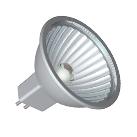The key to any successful landscape lighting design centers on the lamp. Too much wattage or the wrong beam spread causes unwanted glare. Not enough light results in an incomplete scene. When it comes to landscape lighting, a little light goes a long way. Consider using lower wattage lamps than you would normally use in other lighting applications. The provided lamp charts will assist you in selecting the proper lamp for the effect desired. After you choose the lamp, then the correct lamp holder (luminaire) can be selected.
The newer generation of MR16 lamps (shown right) are available in a 10,000 hour lamp life and have a permanent lens over the front of the lamp. This is an excellent option to consider since it prevents accidental touching of the halogen capsule and protects the reflector from dirt, dust, and condensation, prolonging the life of the MR16 lamp. MR11’s and MR8’s are just smaller versions of the MR16. All three sizes are available in a variety of wattages and beam spreads.


LED Lighting is ALL the rage right now. Everyone is wanting to do their part to reduce their carbon footprint, as well as save a little money on their electric bill – and LED’s are a GREAT way to do that. Retrofit LED lamps are slowly but surely being made in all types of wattages and voltages (example shown to the left). So when designing your 12V or 120V lighting project, check out our LED Lamps to see if you can upgrade to an LED retrofit light bulb. Remember that LED’s have superior long life abilities, light output, and effeciency compared to traditional halogen light bulbs.
Keep in mind that all R and MR lamps require a luminaire with a lens to protect the lamp from the elements. PAR lamps are designed with their own tempered glass lens and require no additional protection from the elements.
A corrosive preventive compound applied to the socket when installing the lamp in the fixture will prolong the life of the lamp and make lamp replacements easier.
Lamp charts are available on the Design Information page for the several types of low voltage lamps and 120V lamps. They are provided as a general guide to assist you in selecting the proper lamp to use in your landscape lighting planning. The charts are designed to provide approximate illumination following:
To give you an indication of how much light you need, the average residential street lighting project has an average illumination level of 1/2 to 1 foot-candle of light. Generally, a well-lit statue or tree should be lit at approximately 5 to 7 foot-candles and fill-in lighting should be 1/2 to 1 foot-candle. Traffic areas such as sidewalks and steps should also be lit to approximately 1/2 to 1 foot-candle.
General-purpose lamps such as the #93, #1141 and the #1156 do not project a “cone” of light, but disperse light in all directions. For this reason, the light output from these lamps vary with each luminaire since the output is dependent upon the size, shape and lens areas of the luminaire itself.
We stock only the best manufacturers of outdoor lighting.Here is a list of just some of the manufacturers we distribute and stock:







